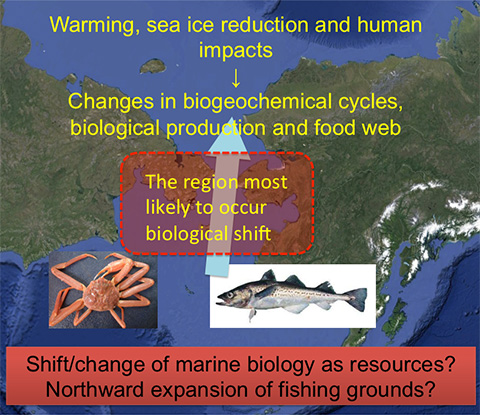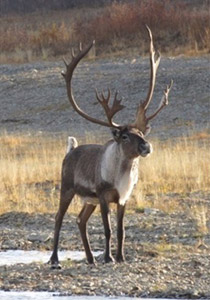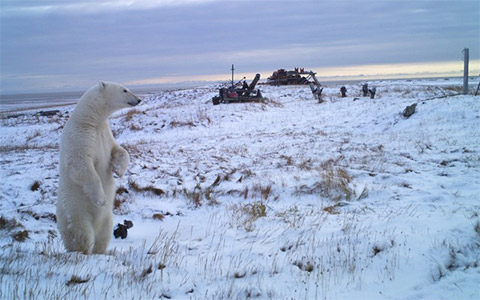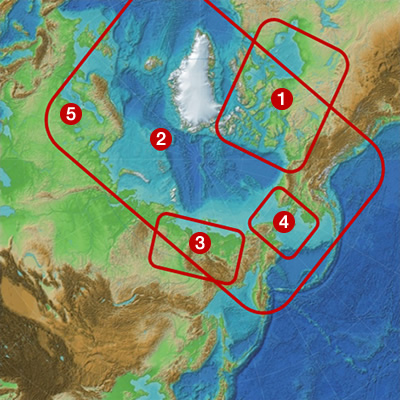Theme 6
Response and biodiversity status of the Arctic ecosystems under environmental change

PI : Toru Hirawake (Hokkaido University)
Study Sites : Canada, Alaska, Siberia, Svalbard, Northern Bering Sea and Southern Chukchi Sea
Background of the Research
Arctic temperatures have increased at almost twice the global average rate for the past 100 years. In addition, a rapid reduction of sea ice in the Arctic Ocean is being observed. These environmental changes are expected to impact on marine biology in the Arctic.
However, little is known about the processes of shifts in marine biology and changes in food habitat, and so these topics should be tackled on an international basis for the sustainability of marine biological resources and conservation of marine biodiversity. Pollutants from low latitudes are also a critical issue for marine biology in the Arctic, and these pollutants are expected to accumulate in higher trophic levels through the food web.
Furthermore, we are still far from understanding ecosystem resistibility and resilience to stresses as well as ecosystem structure, function, and services. Arctic climate change and/or changes in human activity may be stressors on Arctic biodiversity, so studies are necessary to cultivate a better understanding of Arctic biodiversity and to discover how to implement biodiversity conservation.
Overview of the Research
Our goal in this theme is to elucidate response and biodiversity status of the Arctic ecosystems under environmental changes. Major target of research items 1 and 2 are marine and terrestrial ecosystems, respectively.
Research item 1: In this research program, we investigate response mechanisms of marine biology in the northern Bering and the southern Chukchi Seas with respect to environmental changes such as sea ice reduction and human impacts such as fisheries and marine pollution. We then make suggestions on the sustainable use and protection of marine biological resources in the near future. Our study region is the northern Bering and southern Chukchi Seas including the Russian EEZ, where ecological shifts are anticipated. Oceanographic surveys, sampling and experiments regarding marine biology with research vessels and moorings will be carried out. We will try to elucidate the nutrient supply mechanism to maintain high biological production in this region, and evaluate the impact of changes in particle flux on the physiology, ecology and production of zooplankton, benthos and fish. The transportation, accumulation and sources of contaminants in Arctic marine biology will also be examined. Furthermore, we will observe changes in marine environments and primary production on a large spatio-temporal scale using satellite data in cooperation with JAXA. The results of these studies using in-situ and satellite data will be combined with numerical models from another research theme to suggest features in this study region in the near future.
Research item 2: We study from the genetic level to the ecosystem level, as well as from microorganisms to large animals.
In the Eastern Siberia region, we will attach GPS telemetry to investigate the behavioral ecology of animals such as reindeer and polar bears. The data we obtain will be utilized to assess protective zones for the animals and/or for ensuring the safety of local people.
St. Lawrence Island, located on the south of the Bering Strait, has an abundance of seabirds. One of the most visible impacts of climate change for the island is the change in sea ice conditions. In addition, it is projected that melting sea ice in the Arctic will make the Northern Sea Route passable. Although these impacts may affect seabirds, little is known about seabird behavior on the island. We investigate seabird behavior using bio-logging techniques and try to assess the effects on the seabirds of changes in sea ice and ship traffic.
Canada has the world’s widest range of Arctic ecosystems. We investigate the structures and functions of terrestrial ecosystems and analyze ecosystem services using latitudinal gradients to clarify the diversity of ecosystem services. Moreover, the slowest fish in the world, named the Greenland shark, lives in the Arctic sea area, but little is known about the ecology of this species. We investigate how they respond in cold water and the effect of climate change.

Northward shift of marine biology in the Bering and Chukchi Seas

Wild tundra reindeer in Olenek District, Sakha Republic, Russia (Courtesy of the Institute for Biological Problems of Cryolithozone).

A polar bear approaching a human residence area in Kolyma District, Sakha Republic, Russia (Courtesy of the Institute for Biological Problems of Cryolithozone).

We will investigate three levels of biodiversity (genetic, species and ecosystem), with an emphasis on less advanced fields of study (e.g., plant pathogenic fungi). The research will also promote a greater understanding of animal behavior and the structure and function of the tundra ecosystem as it relates to climate change. The information will be translated into a form that will be useful to stakeholders.
Cooperative Institutions / International Projects
University of Alaska (R/V Sikuliaq), University of Washington (RUSALCA, NABOS, DOB, PacMARS), Far Eastern Regional Hydrometeorological Research Institute (Russia), Far Eastern Federal University (Russia), National Oceanic and Atmospheric Administration (US), Institute of Marine Research (Norway), Green Edge Project (Canada), Alfred Wegener Institute for Polar and Marine Research (AWI, Germany), Korean Polar Research Institute (Korea), Pusan National University (Korea), NASA (Arctic Color) *TBD, Scripps Institution of Oceanography, UC San Diego (SIO/UCSD, US) *TBD, Center for Northern Studies (US), University of Tromsø (Norway), Svalbard Science Forum (Norway), Université du Québec à Rimouski (Canada), Université du Québec à Trois-Rivières (Canada), Université Laval (Canada), University of Alaska Fairbanks (US), Institute for Biological Problems of Cryolithozone (Russia), North-Eastern Federal University (Russia), Canadian High Arctic Research Station (Canada)
Implementation Structure
Members
| Name | Institutes |
|---|---|
| Toru Hirawake | Hokkaido University |
| Hiromichi Ueno | Hokkaido University |
| Hiroto Abe | Hokkaido University |
| Atsushi Ooki | Hokkaido University |
| Jun Nishioka | Hokkaido University |
| Youhei Yamashita | Hokkaido University |
| Daiki Nomura | Hokkaido University |
| Makoto Sampei | Hokkaido University |
| Atsushi Yamaguchi | Hokkaido University |
| Kohei Matsuno | Hokkaido University |
| Yoshiyuki Abe | Hokkaido University |
| Orio Yamamura | Hokkaido University |
| Yutaka Watanuki | Hokkaido University |
| Masahiro Nakaoka | Hokkaido University |
| Hisatomo Waga | Hokkaido University |
| Takafumi Hirata | Hokkaido University |
| Irene Alabia | Hokkaido University |
| Jorge Garcia Molinos | Hokkaido University |
| Yukihiro Takahashi | Hokkaido University |
| Yoshio Masuda | Hokkaido University |
| Name | Institutes |
|---|---|
| Masahiro Hori | JAXA |
| Hiroshi Murakami | JAXA |
| Masaki Uchida | National Institute of Polar Research |
| Satoshi Imura | National Institute of Polar Research |
| Akinori Takahashi | National Institute of Polar Research |
| Yuuki Watanabe | National Institute of Polar Research |
| Nobuo Kokubun | National Institute of Polar Research |
| Alexis Will | National Institute of Polar Research |
| Jean-Baptiste Thiebot | National Institute of Polar Research |
| Shirow Tatsuzawa | Hokkaido University |
| Akira Mori | Yokohama National University |
| Shota Masumoto | Yokohama National University |
Collaborators
| Name | Institutes |
|---|---|
| Hideshige Takada | Tokyo University of Agriculture and Technology |
| Mitsutaku Makino | Japan Fisheries Research and Education Agency |
| Shigeto Nishino | JAMSTEC |
| Eiji Watanabe | JAMSTEC |
| Koji Sugie | JAMSTEC |
| Amane Fujiwara | JAMSTEC |
| Bungo Nishizawa | National Institute of Polar Research |
| Nobuhide Fujitake | Kobe University |
| Hiroyuki Muraoka | Gifu University |
| Shinpei Yoshitake | Waseda University |
| Emiko Harada | The University of Shiga Prefecture |
| Masanobu Higuchi | National Museum of Nature and Science |
| Takayuki Nakatsubo | Hiroshima University |
| Takashi Osono | Doshisha University |
| Name | Institutes |
|---|---|
| Dai Hirose | Nihon University |
| Motoaki Tojo | Osaka Prefecture University |
| Tamotsu Hoshino | Hachinohe Institute of Technology |
| Motohiro Hasegawa | Doshisha University |
| Kentaro Hayashi | National Institute for Agro-Environmental Sciences |
| Yasuo Iimura | The University of Shiga Prefecture |
| Ryo Kaneko | Tentamus Japan |
| Hazuki Arakida | Institute of Physical and Chemical Research (RIKEN) |
| Mitsuru Hirota | University of Tsukuba |
| Hideyuki Doi | University of Hyogo |
| Shunsuke Matsuoka | University of Hyogo |
| Yusuke Sawa | BirdLife International Tokyo |
| Toshio Ikeuchi | Foster A Goose Program |
| Masaharu Tsuji | National Institute of Technology, Asahikawa College |
| Ryo Kitagawa | Forest Research and Management Organization |
Study Sites (Map)
- ❶Canada
- ❷Svalbard
- ❸Siberia
- ❹Alaska, Northern Bering Sea and Southern Chukchi Sea
- ❺The whole of the Arctic region (Satellite observation)

ArCS Blog
- Seabird study in St. Lawrence Island, Northern Bering Sea, 2019 (September 09, 2019)
- About board meeting of Conservation of Arctic Flora and Fauna in Anchorage, Alaska, USA (March 04, 2019)
- Ecological studies of Greenland sharks (December 14, 2018)
- Seabird study in St. Lawrence Island, Northern Bering Sea, 2018 (September 21, 2018)
- Salluit Day 5: Thanking people, environment and wonders of Salluit (May 18, 2018)
- Salluit Day 4: Large thalli (individuals) of rock tripe lichens (May 11, 2018)
- Salluit Day 3: Encountering a caribou (April 30, 2018)




